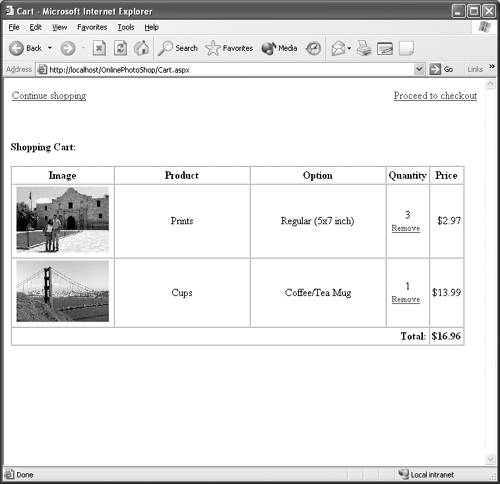Conclusion
|
The implementation of all four requirement keys is now complete. After adding products to the shopping cart in the product browser form, we can click on the Shopping Cart link at the top of the page, which links to Cart.aspx. There, the items are read from the session object and displayed as shown in Figure 11.12. |
Figure 11.12. Shopping Cart Form

In this chapter programming of unit tests has been exercised to a great extent. In doing so, we have achieved a significant improvement:
- Minor problems and bugs have been addressed immediately after initial implementation. If you have worked through this chapter and have not simply proceeded with the sample solutions, you will have encountered failed test cases a number of times (just as we did).
- We have detected resource leaks in the product parser that could have caused system instability due to a lack of system handles. After typical memory leaks were eliminated by the introduction of automatic memory management in the .NET runtime, unreleased resources may become the new challenge to programmers. As we have seen, without strict testing these leaks remain widely undetected but can cause major instabilities for the entire system.
- We have detected a bug in the XmlTextReader class, which is part of the .NET Framework. This is a particularly unexpected problem because XML support is often mentioned as an important feature of the .NET Framework. The fact that a product has a huge installed base may give you the wrong feeling about its quality. To give another example, in our past projects we have come across bugs in basic clipping functions in the OpenGL driver for graphic boards that have sold millions of units. Nobody is perfect!
After fixing a few bugs and implementing a workaround for the problem found in the .NET Framework, our code has passed all unit tests, and the go/no-go criteria for this iteration have been fulfilled. Early testing is a major factor in product robustness. Furthermore, we have shown that even for Web-based applications, fully automated unit tests are feasible.
In the next iteration, the construction phase of this project will be completed with the implementation of a secure checkout procedure for Online Photo Shop.
Introducing .NET
- Introducing .NET
- The Need for .NET
- The .NET Framework
- The C# Language
- Debugging and the IDE
- References for Further Reading
Introducing Software Engineering
- Introducing Software Engineering
- Introducing Software Engineering Practices
- Choosing a Software Development Model
- Commonly Used Software Development Models
- Conclusion
- References for Further Reading
A .NET Prototype
- Getting Started
- Evaluating .NET for Windows Client Applications
- Our First .NET Application
- Prototyping
- Implementing the SmartNotes Application
- Visual Studio.NET: Platform of Choice
- References for Further Reading
Project Planning
- Project Planning
- The Project Vision and Business Case
- The Initial Use Case Model
- Project Requirements
- Initial Project Planning
- Initial Risk Analysis
- Initial Requirements Analysis and Design
- Conclusion
- References for Further Reading
The Photo Editor Application
- The Photo Editor Application
- The Refined Project Vision and Business Case
- Refined Requirements for Online Photo Shop
- Analysis of the Photo Editor Requirements
- Design of the Photo Editor Application
- The Detailed Project Schedule
- Implementation of the Photo Editor Application
- Unit Tests
- Conclusion
- References for Further Reading
GDI+ Graphics Extensions
- GDI+ Graphics Extensions
- Requirements for the GDI+ Extensions
- Analysis of the GDI+ Extensions Requirements
- Design of the GDI+ Extensions
- Project Management Issues
- GDI+ Programming
- Drawing GDI+ Primitives
- Unit Tests
- Conclusion
- References for Further Reading
Advanced GDI+ Operations
- Advanced GDI+ Operations
- Advanced GDI+ Extensions
- Analysis of the Advanced GDI+ Extensions Requirements
- Design of the Advanced GDI+ Extensions
- Project Management Issues
- Using Pens and Brushes in GDI+
- Implementation of Regions, Pens, and Brushes
- Unit Tests
- Conclusion
Dynamic Loading of Components
- Dynamic Loading of Components
- Requirements for Image Postprocessing Components
- Analysis of the Image Postprocessing Requirements
- Design of the Image-Processing Components Using Late Binding
- Project Management Issues
- Implementing Dynamically Loadable Image Postprocessing Plugins
- Unit Tests
- Conclusion
- References for Further Reading
Accessing System Resources
- Accessing System Resources
- Refining Requirements for 3D Text Display
- Three-Dimensional Rendering Technologies
- Analyzing User Interface Needs
- Using OpenGL.NET
- Adding 3D Text to the Photo Editor Application
- Conclusion: Dont Reinvent the Wheel
- References for Further Reading
Performance Optimization, Multithreading, and Profiling
- Performance Optimization, Multithreading, and Profiling
- Requirements for Performance Optimization
- Analysis of the Editor Optimization Requirement
- Design of the Optimizations
- Project Management Issues
- Multithreading and Optimization Implementation
- Unit Tests
- Conclusion
- References for Further Reading
Building the Web Application with ASP.NET
- Building the Web Application with ASP.NET
- Online Store Requirements
- Analyzing Interfaces and Activities
- Breakdown of the Code Modules
- Implementation of Online Photo Shop
- Conclusion
Security and Database Access
- Security and Database Access
- Secure Checkout
- Integrating Externally Supplied Software
- E-mail, Password, Credit Card: Creating a Customer Profile
- Secure Web Applications
- Database Access with ADO.NET
- Putting It All Together
- No Longer under Construction
- References for Further Reading
Product Release
EAN: 2147483647
Pages: 123
